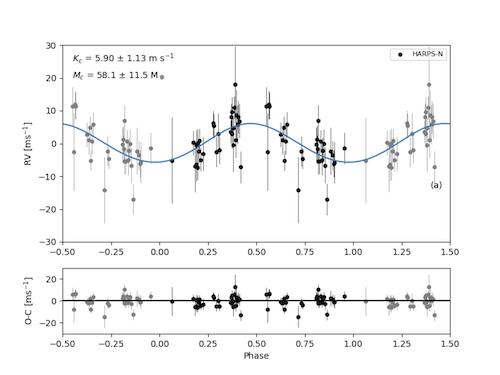Characterising long-period exoplanets
In this work we've been able to characterise the intermediate-mass long-period exoplanets in the PH-2 and Kepler-103 systems.
One of the goals of exoplanet science is to try and determine the composition of exoplanets. One way to do this is to combine transit observations, which give a planet's radius, with radial velocity measurements, which can give a planet's mass. It is often easiest to do things for planets that orbit close to their parent stars. Additionally, there is great interest in trying to characterise the smallest exoplanets, which is currently only really possible if these are on close-in orbits. A consequence of this is that much of this work has focussed on small, close-in planets, and there has been far less work on the more massive planets on wider orbits that it's still possible to characterise.

In work led by Sophie Dubber, we've been able to characterise the wide-orbit planets in the PH-2 and Kepler-103 systems. From transit observations it was already know that PH-2 hosted a 9.5 Earth radius planet with an orbital period of 283 days. Similarly, Kepler-103 was known to host a 5.5 Earth radius planet with an orbital period of 180 days. Kepler-103 also hosts a closer-in planets that we were also able to characterise.
Using the HARPS-N radial velocity spectrometer, we obtained a number of high-resolution spectra that allowed us to determine the radial velocities of the host stars. The figure on the right shows the radial velocity curve for Kepler-103c. From the radial velocity curves we can estimate the planet masses, and combining this with the radius estimates from the transit observations allows us to estimate their compositions.
Our analysis suggests that PH-2b has a mass of about 109 Earth masses, making it the first confirmed Saturn-like exoplanet with a period longer than 200 days. Kepler-103c, with a mass of about 59 Earth masses, is one of the densest known long-period exoplanets.
This work has therefore increased the sample of long-period, intermediate-mass exoplanets with well-constrained masses and radii. This will help us to better constrain the exoplanet mass-period relation across the full range of exoplanets masses and radii and will also help us to better constrain the processes involved in planet formation and evolution.
Link:
Using HARPS-N to characterise the long-period planets in the PH-2 and Kepler-103 systems, Dubber S., Mortier A., Rice K., et al., Monthly Notices of the Royal Astronomical Society, in press.

